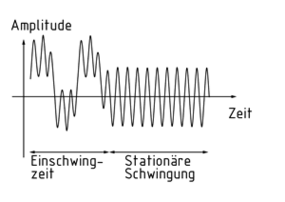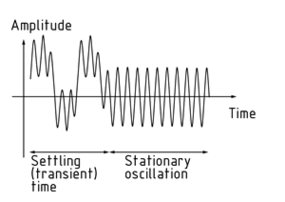
Seleccione uno
o más idiomas
0,1,3
- Alemán
- Inglés
- Chino
- Español
Oscilación forzada

La oscilación forzada ocurre en un sistema oscilatorio y amortiguado (oscilatorio) como resultado de una excitación externa dependiente del tiempo. Después del proceso de asentado (efecto transitorio), la oscilación forzada cambia a oscilación forzada estacionaria.
En un estado estacionario, el sistema oscila con la frecuencia de la fuerza de transmisión. La amplitud depende de la frecuencia de transmisión.
Si una transmisión impone oscilaciones periódicas cerca de la frecuencia natural (rango de frecuencia) del oscilador en el sistema, este reacciona con amplitudes altas. En un sistema oscilatorio no amortiguado, esto puede incrementar la amplitud y causar una catástrofe de resonancia. Todos los sistemas de oscilación vinculados pueden mostrar el fenómeno de resonancia.
Si, en contraste, la frecuencia de transmisión es menor a la frecuencia natural, la transmisión dicta la amplitud.
Si la frecuencia de transmisión es mayor que, y opuesta a, la frecuencia natural, la amplitud baja aún más al incrementarse la frecuencia más allá del punto de resonancia.
Los sistemas pueden forzarse mecánicamente a una oscilación al aplicar periódicamente una fuerza a un cuerpo o al desplazar periódicamente el cuerpo de su posición de reposo.
Oscilación forzada estacionaria
Erzwungene Schwingung

Eine erzwungene Schwingung entsteht in einem schwingungsfähigen und gedämpften System (Oszillator) dann, wenn es zeitabhängig und äußerlich angeregt wird. Die erzwungene Schwingung geht nach dem Einschwingvorgang in eine stationäre und erzwungene Schwingung über.
Im stationären Zustand führt das System die Schwingungen mit der Frequenz der treibenden Kraft aus. Dabei hängt seine Amplitude von der treibenden Frequenz ab.
- Zwingt der Antrieb dem System periodische Schwingungen in der Nähe der Eigenfrequenz (Resonanzbereich) des Schwingers auf, reagiert dieser mit großen Amplituden. Im ungedämpften Schwingungssystem kann dies zum Anstieg der Amplitude und bis zur Resonanzkatastrophe führen. Resonanzerscheinungen können alle gekoppelten Schwingungssysteme zeigen.
- Ist die Antriebsfrequenz dagegen kleiner als die Eigenfrequenz, wird die Amplitude vom Antrieb vorgegeben.
- Ist die Antriebsfrequenz größer als die Eigenfrequenz und gegenphasig ausgelenkt, wird die Amplitude bei zunehmender Frequenz oberhalb der Resonanzstelle immer kleiner.
Mechanisch kann die Schwingung von Systemen durch eine periodische Kraft auf einen Körper oder seine periodische Verschiebung aus der Ruhelage erzwungen werden.
Forced oscillation

Forced Oscillation occurs in an oscillatory and damped system (oscillator) as a result of time-dependent external excitation. Following the settling process (transient effect), the forced oscillation changes to stationary, forced oscillation.
In the stationary state, the system oscillates with the frequency of the driving Force. The amplitude depends on the driving frequency.
- If the drive imposes periodic oscillations close to the natural frequency (frequency range) of the oscillator on the system, it reacts with high amplitudes. In an undamped oscillatory system, this can increase the amplitude and cause a Resonance catastrophe. All linked oscillation systems can exhibit resonance phenomena.
- If, by contrast, the drive frequency is lower than the natural frequency, the drive dictates the amplitude.
- If the drive frequency is higher than, and in opposition to, the natural frequency, the amplitude gets ever lower as the frequency increases beyond the resonance point.
Systems can be forced into oscillation mechanically by periodically applying a force to a body or periodically displacing the body from its rest position.
强迫振荡

在一个有阻尼的振荡系统中,如果激发振荡的外力有一定的时间规律,那么,其结果就会造成该系统出现强迫振荡 的现象。随着过渡过程(瞬态效应)的完成,强迫振荡会变成一种平稳的强迫振荡。
在平稳状态下,系统将按照外力的频率进行振荡。振幅度取决于外力频率的大小。
在对系统振荡器施加外力实现周期性振荡的情况下,如果外力频率接近振荡器的固有频率(频率范围),振荡器将具有较高的振幅反应。在一个没有阻尼的振荡系统中,这样的外力可以提高振荡的振幅,并导致共振灾难。在所有的振荡系统中,都可以发生共振现象。
与此相反,假如外力的频率比固有频率低,那么,振荡的振幅将取决于外力的大小。
假如外力与上述情况相反,即假如外力频率高于固有频率,那么,在外力的频率超过共振点频率之后,振荡的振幅将变得越来越低。
可以通过周期性地给某个物体施加外力的方式,或者周期性地让物体离开其静止位置的方式,利用机械手段强迫物体进入振荡状态。
平稳,强迫振荡
